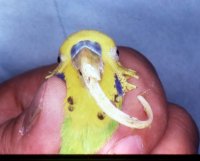 Back
Back
BEAK OVERGROWTH AND DEFORMITY IN BUDGERIGARS First broadcast on www.provet.co.uk |
This information is provided by Provet for educational purposes only.
You should seek the advice of your veterinarian if your pet is ill as only he or she can correctly advise on the diagnosis and recommend the treatment that is most appropriate for your pet.
Beak Overgrowth and deformity is common in Budgerigars
Budgerigar beaks are usually kept in normal shape by daily eating and use of the beak to help the bird move around it's cage. If the upper and lower beaks do not meet properly (called malocclusion) they may not wear properly leading to overgrowth and deformity. There are also other causes of beak overgrowth and deformity including a parasitic mite, nutritional deficiencies and other diseases. These require proper diagnosis and prescription treatments so you should take your bird to your veterinarian so that the underlying cause can be identified and treated properly.
Once a beak is deformed regular trimming with scissors and/or a nail file or sandpaper is usually necessary, otherwise your bird might not be able to eat properly. If you are over-zealous the beak can bleed - sometimes a lot !!, and this needs to be stopped using a silver nitrate pencil. Unless you are confident about what you are doing beak trimming is best performed by a veterinarian.
Contrary to popular belief many authors do not think that the use of cuttle bones or mineral blocks helps to keep the beak in good shape.
Updated October 2013
